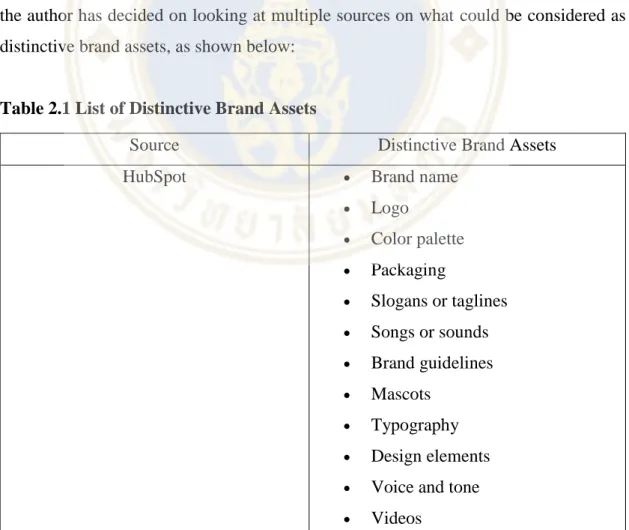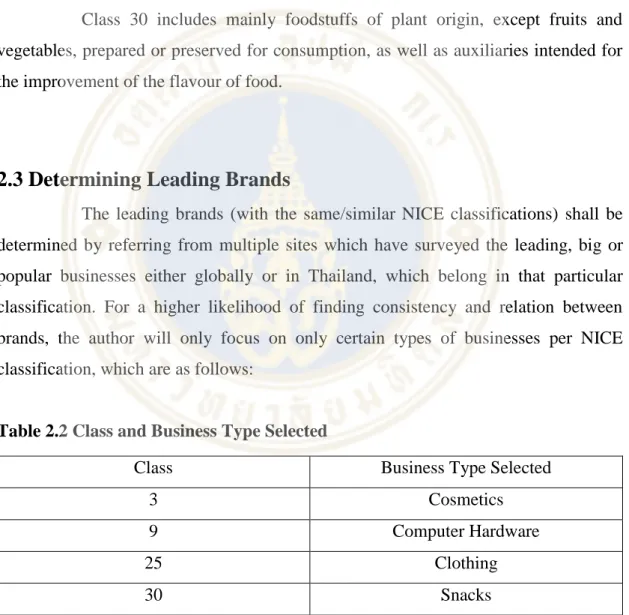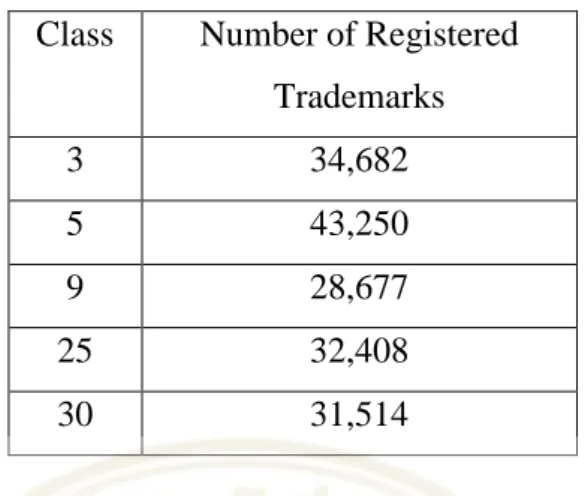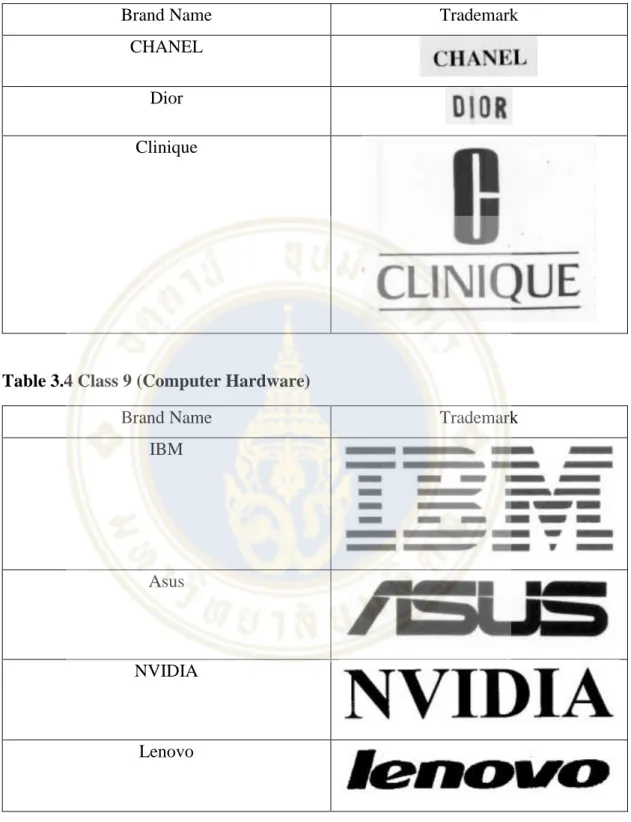At the end of this publication, I would like to express my gratitude to the advisor of this publication, Associate Professor Dr. Randall Shannon, for his advice and perspectives on how this publication could be viewed from a different perspective, as well as for possible improvements made to this publication. They have supported me with their encouragement, knowledge of their efforts and improvements, and their inspiring publications, set as examples for me to strive for in the completion of this publication.
LOOKING AT THE CHARACTERISTICS OF THE LEADING BRANDS: HOW SHOULD A BRAND'S TRADEMARKS BE DESIGNED IN DIFFERENT INDUSTRIES. This publication aims to highlight certain consistencies and trends between distinctive brands from different industries from trademark perspectives. The methodology used for this publication involves observation and analysis of leading brands from four different industries with the largest number of registered trademarks in Thailand, respectively cosmetics, computer hardware, clothing and snack products.
The findings of this publication showed that different industries have different types of consistencies and trends from different brand assets. The main objective of this publication is to serve as a possible pointer or a guide for trademark designers for new or new businesses. The author strongly hopes that this publication will serve as a strong point to create in terms of creating awareness of the possible relationship between the designs of leading brands in different industries.
While this publication may not fully expose the reasoning behind such relationships, the author hopes that this publication will serve as an inspiring starting point for future researchers to explore and study the extent to which these relationships may influence brands in terms of marketing and marketing. . company.

LITERATURE REVIEW
- Distinctive Brand Assets
- Industry Classification
- Class 3
- Class 5
- Class 9
- Class 25
- Class 30
- Determining Leading Brands
- Trademark Analysis
- Brand Portfolio
- Vienna Classification
Only distinctive brand assets mentioned in more than one source are included in the list below. The industry of all considered brands will be divided according to the NICE classification. Further details on which classes have the most trademark registrations are counted as data set in Chapter III: Research Methodology.
The brand analysis will be done less subjectively, but more on the basis of the analysis on various brand publications. One trademark may have multiple trademarks or more, depending on the owner of the trademarks. It has been investigated that 75% of the brands own one brand, while 5% of the brands own five or more brands (Krasnikov, 2022).
The Vienna Classification is the international classification of the figurative elements in trademarks (World Intellectual Property Organization, 2022). In this publication, the analysis will focus on specific "figure elements" which are categorized into 29 different categories such as symbols, writing, colors and more.
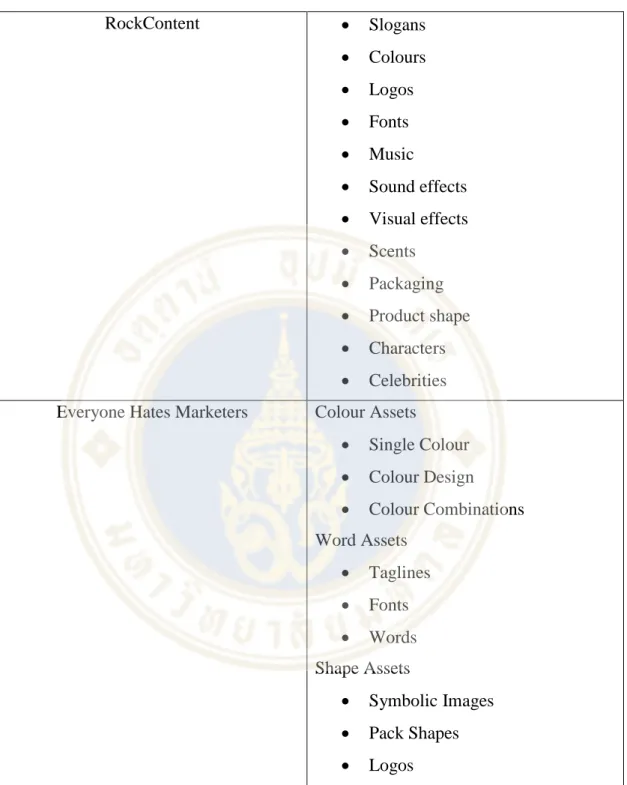
RESEARCH METHODOLOGY
- Data Collection Method
- Industry Classification (through NICE Classification) Method
- Number of Registered Trademarks
- NICE Class Definition
- Brand or Trademark Selection Method
- Distinctive Brand Assets
- Additional Questions
- Publication Framework
As can be seen from the data collected in Table 3.1, the author wishes to highlight four notable NICE classifications with the highest number of registered trademarks for further brand/brand selection. Despite having the most registered trademarks, Class 5 will not be included in further data collection and analysis. This is because Class 5 mainly represents pharmaceuticals, which is not meant to be a common industry for new or start-up companies.
As already explained in Chapter 1: INTRODUCTION, this publication is intended to assist those who wish to design brands for new or emerging businesses. The brands or their brands are selected by reference to research that has focused on the best or most popular brands in that particular business in each NICE classification (as noted earlier in Chapter II: Literature review). If a brand has registered more than one brand, one brand will be selected based on the use of the brand (eg packaging, social media, websites, etc.).
Are there any certain colors that the leading brands seem to use in that particular industry. How common is it in that particular industry to register such trademarks with unique fonts or typography. Are there any specific characteristics of such logos or symbolic images in that particular industry.
This publication aims to compare the findings of possible similarities and relationships between the brands of the leading brands within the same industry. Such similarities and relationships are based on the grounds of distinctive brand assets, as well as distinctive brand asset-based questions designed by the author. After analyzing such findings, this publication will aim to provide practical recommendations on what to consider when designing brands for different industries.
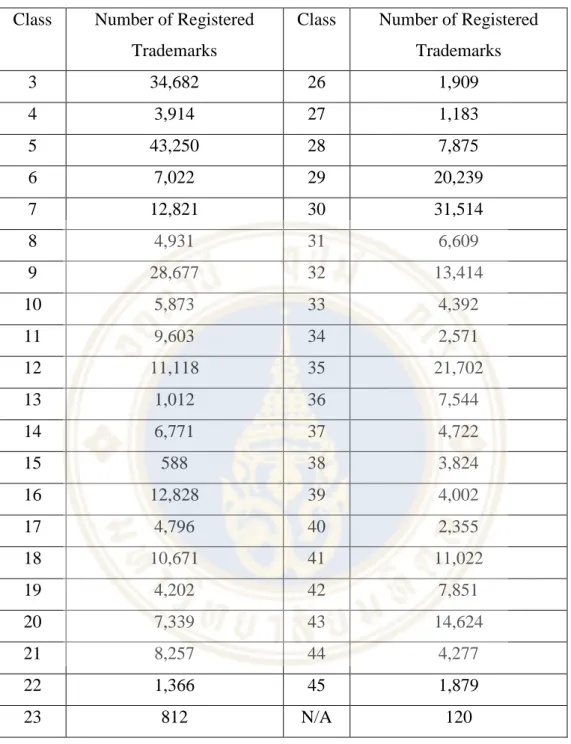
DATA ANALYSIS
- Class 3 ( Cosmetics)
- Class 9 (Computer Hardware)
- Class 25 ( Clothing)
- Class 30 ( Snacks)
Another interesting finding of L'OREAL Paris is that the trademark only covers the formulation aspect of the brand. This means that as long as the wording part of the trademark is registered, wordings can be designed in different types of linings. To expand further, the author decided to look at the number of registered trademarks of other selected brands as well.
The following table shows the number of registered trademarks in Thailand of the selected brands, taken from the Global Brand Database. As with L'OREAL Paris, most registered trademarks of other brands are usually in text. Most registered trademarks contain specific text in both Thai and English for specific editions of the products, or the slogans (Department of Intellectual Property, 2022).
Clinique is one of the less common examples of brands analyzed, which has a registered logo as well as its use on actual product packaging. In terms of color, it seems that most of the selected brands have cool or dark color schemes. Interestingly, Lenovo's registered trademark covers both the typeface design and the Lenovo text itself, which is legal under the Vienna Classification category "27.5.5 Letters containing written or typographical matter" and "27.5.24" .
Lenovo is the rare case among the analyzed brands where more than one color palette or color scheme is used in the trademark. But it is unclear whether text trademarks and logos are consistently used on products. However, it is unclear whether this consistency can be confirmed as a pattern as the sample size of the selected brands could be larger.
This pattern of brand inclusion also appears to be the same on most of the apparel products. The images above reinforce the fact that clothing companies generally do not display their brands explicitly on their clothing products, while some of the brands may not even have a logo at all (Liu, 2020). This is because snack products tend to use several different colors for their packaging to communicate vivid and fun aspects of the product (Chen, 2019).
Despite showing different colors on the product packaging, the color of the logo trademark remains the same. It could be inferred that not only trademark designers should consider protecting the wording and logo design aspects, but also the packaging as a whole.
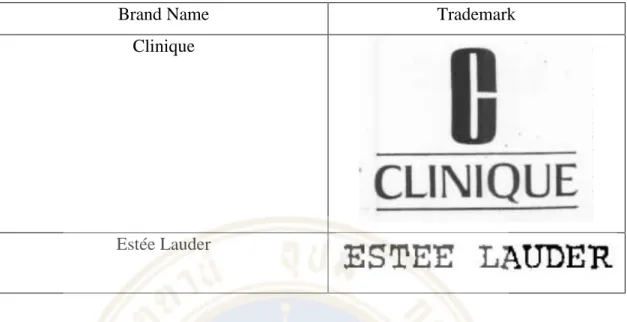
RECOMMENDATIONS AND CONCLUSION
Conclusion
- Class 3 (Cosmetics)
- Class 9 (Computer Hardware)
- Class 25 (Clothing)
- Class 30 (Snacks)
- Alternative Trademark Usages
Brands in this industry focus their trademarks similarly or equally on both texts and logos. Compared to the other analyzed industries, food products have more registered trademarks on packaging than just texts and logos. Although not related to consistency and trends, the author would like to point out some of the unusual uses of trademarks, but also possible for new business owners or brand designers.
Combine two different parts of the brand into one by placing them next to each other on the product packaging (eg text branding next to logo branding).
Recommendations
When designing brand elements or brand assets for their new businesses, one should consider what kind of industry their business is perceived to be in. Especially from this publication, which showed that such consistencies and trends exist among the high-end brands. If possible, find and explore the reasons for such consistencies and trends for the distinguished brands in their industry.
Limitations of Publication

